Day 3 August 18, 2002 0100 17.03S, 150.27W Log: 60,853 Baro: 1012 Cabin Temp: 84F Closehauled at 4.1kts in 5.5kt N(!) winds 37 miles to Huahine, Iles Sous le Vent
Within 45 minutes of our past Leg 2 crew setting off for adventures on their own in Tahiti, Amanda and I set sail for Moorea, 21 miles west of Tahiti. The cold front with 25-30kt SE winds that had roared through our Papeete anchorage at Maeva Beach, causing crew stand anchor watch on their last night, had blown through, leaving cloudless skies though lots of wind and a substantial swell that crashed on Tahiti’s SW facing reef, to the delight of the surfers.
Speaking of surfing, with winds between 32 and 39 kts for the passage to Moorea, Mahina Tiare was in her element, touching 12 knots in one surge, with boatspeed rarely
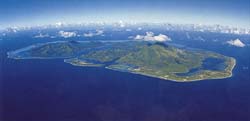 Huahine |
dropping below 9 knots. We covered the 21 miles in record time, even managing to catch but not land a fish as we sailed past Pointe Aroha on Moorea’s NE corner. I couldn’t stop grinning – these were the conditions I kept dreaming about a year ago as we crossed the bitter North Sea between Germany and England. Finally, it REALLY felt like we were back sailing in Paradise!
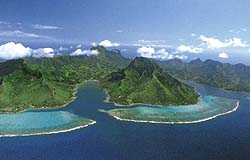 Aerial view of Cook and Opunohu Bays |
For a week we enjoyed two of our favorite anchorages, the first shared with a sistership, Heron, owned by friends from Hawaii in front of former original Bali Hai Hotel and the second in Opunohu Bay. We enjoyed morning runs up the valleys followed by a swim and managed to accomplish a record six coats of varnish in six days, plus ticking off jobs on the repairs and maintenance list. On our last afternoon we hiked three hours up to Belvedere, a scenic lookout over both Cooks and Opunohu Bay.
We are here 2 months later than when we usually sail up from New Zealand and have encountered more yachts on Tahiti and Moorea than previous seasons. The Port Captain said we were the 367th foreign boat to check in and that on average Tahiti has 350-450 boats a year passing through. I think concern over El Nino conditions, the economic climate and the increased Panama Canal fees have reduced the number of cruisers in the South Pacific this year, which is balanced by a few extra yachts sailing to Auckland to watch the America’s Cup.
This year a change in French Polynesia’s immigration policy has caught many cruisers, and even the Gendarmes in the Marquesas and Tuamotus by surprise. For the past ten years or so, foreign boats arriving in French Polynesia were automatically given a three-month visa which could be renewed for another three months if a request in writing was forwarded to the High Commissioner in Tahiti. Now it’s necessary to leave the country to apply for the second three months. The two options most used by cruisers are one-week excursions to either Easter Island or Hawaii. For future cruisers a better alternative is to apply for a six-month visa from any French Consulate before arriving.
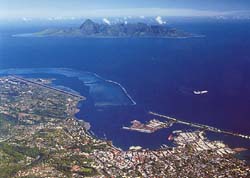 Papeete Harbor, Moorea Island in the background |
European Community citizens fare much better, having no immigration entry formalities at all! With her British passport Amanda can stay one year and doesn’t have to fill out any paperwork, not even an entry card or post the bond money of an airline ticket home We will mention these changes in the latest update that we are writing for Charlie’s Charts of Polynesia.
Another major change is the famous waterfront quay of Papeete. The area with a concrete bulkhead, power and water has quadrupled in length, though we saw only a handful of cruising boats as most cruisers prefer the quieter reef anchorage south of the airport near the Maeva Beach Hotel, Taina Fuel Dock and Carrefour Mega Store.
Now that you’re caught up here’s the start of Leg 3.
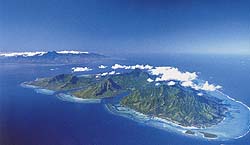
Moorea
|
Crew joined us noon on Friday although I had already collected their passports the previous night and completed the paper work with Immigration and Customs. Our original plan was to spend Friday afternoon on safety and navigation orientation, but once everyone was aboard, Amanda said, “Why don’t we sail to Moorea now, instead of tomorrow” No one objected.
In short order we were powering across a flat Sea of the Moon as El Nino results in lighter winds over the South Pacific, but our bonus was when Ron, a keen fisherman who had been watching our fishing lines yelled, “We’ve got a fish!” Both these events were two major firsts as in the 28 years that Amanda and I have made this passage, we’ve never motored or landed a fish. And what a fish! A 30lb wahoo (Spanish Mackerel) that filled our tummies, the fridge and the freezer. What a treat!
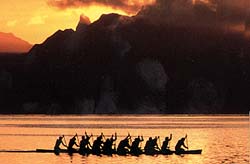 Paddling at sunset |
Yesterday was a busy one, as after delicious morning swims in the lagoon we seriously launched into our safety and gear orientation, followed by most of the crew heading off for a hike up to Belvedere, a photo shoot sailing back and forth in front of the spectacular lush green mountains and cliffs of Opunuhu Bay, where Captain Cook had sailed, and setting sail for Huahine before dark.
At a distance of 84 miles, it’s slightly too long of a passage for daylight hours, so most cruisers leave Moorea at sunset, planning an early morning landfall at Huahine. The light winds have gradually filled in and are hovering around 6 knots, allowing us to sail at 5 knots. The moon is 2/3 full, there are a zillion stars spilling from the Milky Way that’s stretched across the sky, and life is good aboard Mahina Tiare! August 18, 2002 1940 16.43S, 151.02W, Log: 60,899, Baro: 1013, Cabin Temp: 82F At anchor, Huahine
Last night the winds stayed with us, though never more than 8 knots, they were rarely less than 5 knots. With diamonds and moonlight teasing the inky black sea, and caressing warm breezes filling our sails we were all enchanted by the night and happy to be silently slipping along at an effortless 4 – 5 knots. By sunrise we were only a few miles from Huahine with a fading breeze but dazzling sunny skies. We motored into Passe Avamoa and anchored in the lagoon off the village of Fare. Within minutes we had all dived into the crystal clear turquoise water that felt like being in a tropical aquarium.
Ashore Fare was experiencing a very quiet Sunday afternoon, with the three Chinese grocery/hardware stores closed for the day. The only sign of business were four or five roulettes, or Tahitian food trucks, with hibachis blazing away and a table of Tahitian mama’s making lei’s and sewing tifaifai quilts. With a population of 5,600, Huahine is quieter and more rural than Tahiti or Moorea.
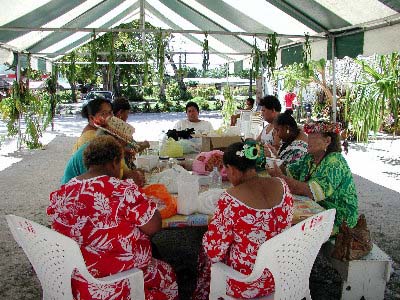
Tahitian women weaving and sewing in Fare, Huhahine
After returning to Mahina Tiare, Oystercatcher XXXV also joined the anchorage. We had briefly seen her in Spitsbergen when Gary Jobson was aboard with owner Richard Matthews, making an ESPN television show. We had then drooled over Oystercatcher, an Oyster 53 in Southampton Boat Show and knew that Matthews owns Oyster Yachts. At least two of our past expedition members, Rosemary and Keith Hamilton and Mariusz Koper have ordered or taken delivery of new Oysters, so we have also been following the line with interest. Not really knowing the crew we were surprised when Richard Matthews sent his captain over to invite our ENTIRE crew aboard for sunset drinks. Matthews has been a keen racing sailor for 30 years, owns a 12 meter America’s Cup yacht and was initially involved in the present British America’s Cup challenge so it was an interesting time for us as we talked about the upcoming America’s Cup and heard the future plans for Oyster Yachts.
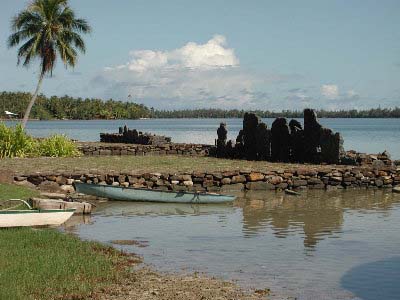
One of the many Maraes (temples) at Lake Maeva
 Aerial view of Bora Bora with Raiatea, Tahaa and Huahine in the background |
Three miles North of Fare at Maeva, Muffet Jourdane, a friend of Dorothy and Mark’s, is working on an archaeological dig for Hawaii’s Bishop Museum under the direction of Yoshi Sinoto, long the preeminent Pacific archaeologist. Excavation in this area started in 1923 and the site map lists 35 ceremonial marae sites.
We all cycled to the site and were guided around by Muffet and by Eric Komori who explained the large traditional meeting house/museum on stilts over the lagoon and various stone maraes or temples which face Lake Maeva, remnants of the previous culture. Eric explained that the oldest sites in the Society Islands date to 850-1000 AD, and that the reason this Huahine site is so large, covering dozens of acres, was that for 400-500 years the island had not suffered inter-family or inter-tribal warfare Eight brothers had divided the island but remained harmonious and built the temples together with their only concerns being raids by warriors from Raiatea, Bora Bora and Tahiti.
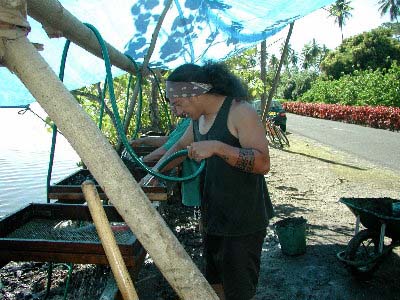
Tahitian site worker washing the
archeological dig soil in search of artifacts
Work on the present archaeological site had been going for two weeks, with Bishop Museum and Hawaii State Historic Preservation staff assisted by volunteer grad students from Japan and Norway and local workers. While we were watching, a student uncovered a beautiful mother of pearl shell coconut grater at a house site and a large carved wooden log used in tapa cloth making was unearthed at a meeting house stone wall.
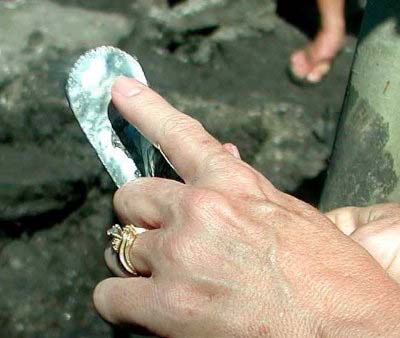
Coconut grater made from a large pearl shell
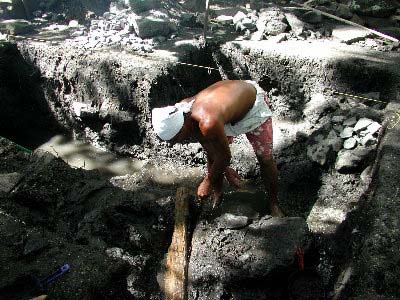
Tapa log being unearthed from meeting house site
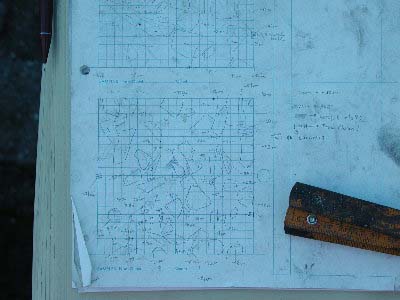
Map of a 10 cm layer of the house site

Archeologists and Amanda at the meeting
house site discussing tapa making
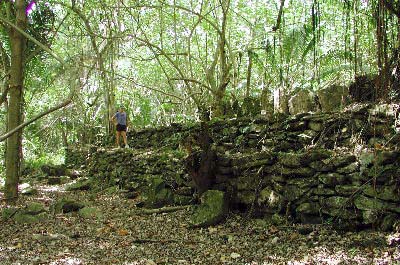
Marae Tefano
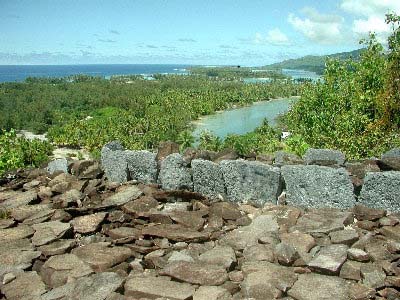
Marae Paepae Ofata overlooking Huahine’s NE coast
Sam was the only one who cycled around Huahine while the rest of us ended up having picnics on the beach or at the hotel.
After an interesting snorkel in Fare’s pass, we studied coastal piloting and navigation and set sail for Raiatea, 20 miles west of Huahine. We started with less than 5 knots of wind, but soon we had 7-9 knots on a lovely close reach across in unusual NW winds. We anchored (for my first time in 28 years) off the most sacred religious and navigational site in all of Polynesia, Marae Taputaputea (holy, holy place).
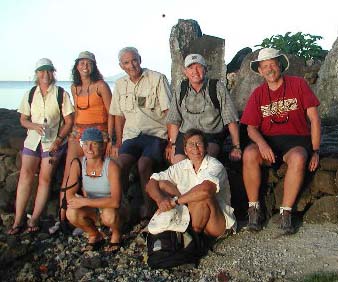
Leg 3 crew at Marae Taputaputea, Raiatea
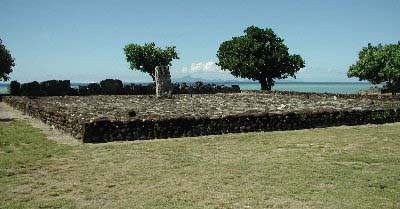
Marae Hauviri, Taputputea
During our visit ashore before sunset, we marveled at the extensive religious platforms, all well maintained, and dating only to the 17th century. It was from this site that Polynesian voyagers sailed south to discover and settle New Zealand, and also departed on voyages to Hawaii and Rarotonga, on their 80′ long catamarans. This site was so important that chiefs sailed here from the Australs, Cooks and even New Zealand for important ceremonies. We quietly watched the sunset over the rugged mountains of Raiatea and went swimming in the moonlight, finding a powerful magic in this tranquil place.
Day 13 August 29, 2002 1000 16.26S, 152.14W
Log: 61,041 Baro: 1016 Cabin Temp: 84F
At anchor, Maupiti Island, 30 miles west of Bora Bora, French Polynesia
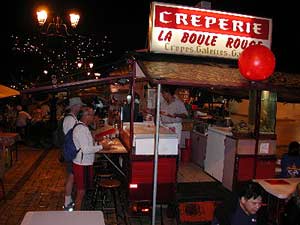 Trying to untangle ourselves from the jungle after taking a wrong turn |
Lest you think it is all teaching and no play, on Day 5 after class we motored a few miles north up to the head of Baie Faaroa, and took the dinghy up the only navigatable river in French Polynesia – or rather, we tried to take the dinghy up the river. It had been several years since we had done this, and I didn’t realize there were two separate rivers opening into the bay, both entrances partially obscured by mangroves and palms. The river I mistakenly chose ended up with us stuck in a tangle of branches, laughing so hard we nearly cried! The dinghy ended up full of leaves, branches, and spiders, much to Zahra’s dismay, as her job for the day was dinghy cleaner. On our way back we passed a local who gave us the oddest look and in Tahitian tried to explain we were in the wrong river. Once we figured it out, we motored over a mile up the main river past manicured banks and plantations, under overhanging trees with birds flitting back and forth and spied rugged green peaks through the gaps in the tropical canopy.
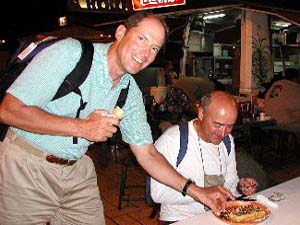 Zahra removing the jungle debris from the dinghy |
Day 7 on Raiatea brought a forecast of a cold front passing over in the late afternoon bringing 25-35 knot southerly Maramu winds. What a perfect time to do our marine weather class. We discussed sources of marine weather when in isolated places, looked at weatherfaxes from New Zealand and Honolulu and listened to a translation from French (by a cruiser in Tahiti) of the local forecast. As a conclusion we studied the general dynamics of marine weather covering cold, warm, occluded and stationary fronts, highs, lows, ridges, troughs and convergence zones, plus overall weather systems for the Atlantic and Pacific, use of Pilot Charts and World Cruising Routes, hurricane seasons and effect of El Nino. Our Leg 3 crew did great – lots of good questions, and I’ll bet a high level of retention for our test, and more importantly, for use on their own boats.
We carefully studied the chart of Tahaa, a dramatic island two miles north of Raiatea that shares the same barrier reef, trying to find the best anchorage in strong S or SW wind conditions. We chose a small bay on the N end of Tahaa and on the way stopped and snorkeled by Passe Toahatu before having a lovely quiet sail under headsail along the dramatic coastline. We kept a constant lookout to the south for bands of low clouds that would signify the arrival of the front, but as the front hadn’t shown we anchored in a tiny hole 1.2 miles north of our chosen storm anchorage. When Amanda first joined me aboard MTII in 1994 we had spent a week here, surrounded by 2′ deep water, in a small sandy-bottomed pocket with 60′ depths and a dinghy channel to the outer uninhabited islets and reef.
Soon after we anchored, a French boat came in, looking for an anchorage, only to discover how tiny the anchorage was and sail on.
We took the dinghy ashore and hiked along the outer reef where we collected plastic rubbish and we admired the sea and tide pools. After returning to Mahina Tiare where Amanda had been standing anchor watch, a 30′ Canadian sloop singlehanded by a gentleman we had met earlier cruised into the tiny anchorage and promptly ran aground, getting well stuck between two coral heads on a falling tide. Amanda, Zahra and Ron donned masks and fins and swam over to lend a hand as I brought the dinghy over. With three sets of eyes underwater our crew directed me which way to push with the dinghy, as they stood on the coral, pushing and shoving the boat into deeper water. After he was free, we invited Dean to join us for dinner in the anchorage on Tahaa we were leaving shortly for. Dean works occasionally as a movie location manager in Vancouver, and his wife, a Kiwi, is a retired ballerina who teaches Pilates on Bermuda.
It did blow that night, and rained enough to half fill the dinghy. We stood anchor watches, but with good protection from the south, great holding and lots of chain out, we didn’t have a worry!
Day 9 The previous nights’ cold front had created a large southerly swell and the Pass Papai on the SW corner of Tahaa had huge seas and lots of contrary current. We knew it would be a rough passage but our crew was interested in heavy weather experience, so we double reefed the main and hung on. With winds gusting in the 30’s Elizabeth hit the highest speeds, repeatedly passing 10 knots as we surged along toward Bora Bora.
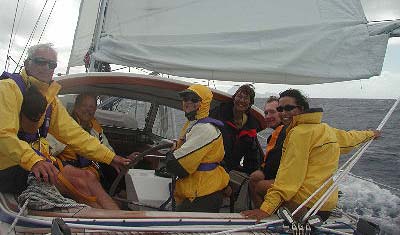 All smiles as we surge towards Bora Bora |
As Day 10 was a Sunday and most things ashore including the Gendarmerie, where we needed to check in, were closed. We opted to go sailing inside Bora Bora’s spectacular lagoon for sail practicing tacking, gibing, reefing and Lifesling Overboard procedures. In Faanui Bay with the winds gusting from 10-30 knots down the rugged valley our crew were given a great work out. Next we sailed around to the windward side of the lagoon through a narrow blasted channel with only 16″ of clearance under the keel. We stopped at our favorite Bora anchorage, behind an islet on the far windward corner of the lagoon and anchored with just 2′ of water under the keel in water so clear we could watch sting rays glide by. Ron spotted an octopus, Elizabeth more rays and a moray eel, and Amanda found that the hundreds of blue damselfish loved stale French bread.

Sailing inside Boar Bora’s lagoon
Early Monday we returned to anchor off Bora Bora Yacht Club where we could easily walk to the town of Vaitape. Ron, Zahra and Sam biked the 20 miles around the island, Mark & Dorothy went shopping and Amanda and I took care of clearing out, retrieving my immigration bond and reprovisioning. Tuesday morning Elizabeth and Zahra went scuba diving with a local dive operator while we topped up our water tank and did a little laundry at Yacht Club. That afternoon we sailed to the far south side of the lagoon to anchor by ourselves in a spectacular spot. We again enjoyed great snorkeling in clear, shallow water followed by a tropical sunset.
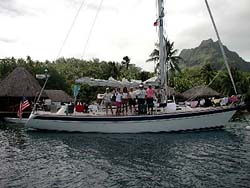 M.T on Bora Bora Yacht Club’s water mooring |
 Zahra, Amanda and Elizabeth demonstrating how big a manta rays mouth is |
Day 12, yesterday, was a great day for the 30-mile passage to Maupiti, a miniature version of Bora Bora, with only 1/10th the population, 500 instead of 5000. Perfect following seas and winds meant that we arrived at the narrow pass at exactly noon, always the time of high slack water in the Society Islands. Ashore we found a friendly, unhurried atmosphere, nearly untouched by the surge in tourism that has recently affected Bora Bora. Sam & Zahra walked the seven miles around Maupiti, accompanied part way by some young girls on bicycles.
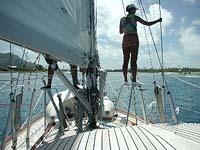 Mark and Zahra guide us through the Maupiti’s twisting pass |
 Landscaping the pathway of a picturesque house on Maupiti |
 Maupiti boys proudly showing us their fighting cocks |
Today, Day 13, has been Amanda’s day for teaching. After sending each expedition member aloft carefully in the bosun’s chair to do a rig check, she showed them how to strip and clean winches and is now just finishing teaching how to splice double-braid line. Earlier Zahra plotted our course to Mopelia, an occasionally inhabited small island 100 miles west of here. We will wait until late afternoon to set sail so we won’t arrive too early at Mopelia.
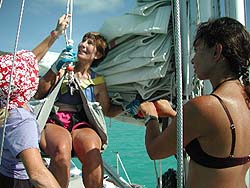 Amanda teaching safely going aloft |
Here’s our Leg 3 crew:
Zahra Elmekkawy, 34, originally from Cairo, Egypt was working in Basel, Switzerland for the Bank for International Settlements before joining us. She will return to New York City where she works for the Federal Reserve Bank. Zahra has become hooked on sailing and is wondering if there is a nice guy with a seaworthy boat in the greater New York City area that she could go sailing with to continue improving her skills.
Elizabeth Ells, 66 originally from Croyton, England but has been living in Ontario where she worked as a biologist at a nuclear research facility before raising three daughters. Chuck, her husband of 38 yrs recently passed away, and she is determined to experience all of the things she has put off in the past. She lives on Ottawa River and sails her Naiad 18 off a mooring in front of her house. What a positive attitude this woman has! Elizabeth is usually the first one in and the last one out of the water. She and Amanda often stay up until the wee hours playing Scrabble in the cockpit.
Dorothy Hazlett, 54, and a psychiatric nurse and avid snorkler from Honolulu has 20,000 miles of cruising experience, much of it in the South Pacific aboard a 57′ ketch that she and her previous husband built over 3.5 years. She and her husband,
Mark Hazlett, 52, a marathon runner and lawyer in Honolulu, sail their Catalina 34 out of the Waikiki Yacht Club. Dorothy and Mark’s four children have nearly flown the nest and they are considering upgrading to a larger boat after retirement in a few years to sail to Alaska, B.C. and possibly Chile.
Ron Poulton, 54 of Rancho Mirage, California, has long been fascinated with the South Pacific. In his 30’s, he signed on to crew on an Alden ketch from LA to Tahiti. When the skipper turned around because of seasickness, Ron hopped on the next flight and spent three months crewing on three different boats around the Societies. He later moved to Kauai for six years, before settling in the desert. Ron doesn’t let a successful real estate career keep him from 6-8 weeks off each summer, and is considering purchasing his own boat and sailing it to Tahiti in the next few years.
Sam Parker, 59 from Newport Beach and Palm Springs, CA joined us last year from San Diego to Acapulco and signed up for three consecutive legs this year. Sam is part owner of an Island Packet and Hatteras yacht dealership and keeps a Duffy electric boat tied up to his dock. Always thinking ahead and ready to do what needs to be done, it is a pleasure to welcome Sam back aboard!
Day 16, September 1, 2002 2200 hrs
17.13S, 154.33W Log: 61,209 Baro: 1016 Broadreaching at 7.3 kts in 23 kt ESE winds
After a perfect overnight broad reach, we arrived at Mopelia’s pass at exactly noon on Day 14, the time of high slack water. Slack water is a bit of a misnomer at Mopelia as we measured 3.6 kts of current against us in the pass, which is a 100′ wide gash in the coral reef. In lining up the entrance we appreciated two steel posts, set on the reef on each side of the pass, plus one small fishing float on each side at the inside end of the pass to mark the narrow and shallow channel. We always had at least 8′ of water under the keel and although
 In the middle of Mopelia’s narrow reef pass |
I’ve entered before it’s still slightly scary. As we had solid 20-knot easterly winds, we carefully motored across to the sheltered side of the lagoon, dodging reefs and numerous pearl farm floats some just below the surface.
We were surprised to find two Spanish yachts, an Italian-Brazilian couple on an HR 45 and a San Francisco couple on an Esprit 37 anchored off a couple of thatched huts ashore. Soon after we anchored, the couple on the Esprit named Reflections, zoomed over in the RIB, inviting us to a barbecue with the locals on the beach. They said the other yachts had been there over a week and had been enjoying the hospitality of Gretta who invited everyone on spear fishing and lobster trips during the mornings and potluck barbecues each night.
After a swim Amanda got busy and baked a tasty cobbler, I made a big batch of popcorn and crew made a big cole slaw and lots of garlic bread to heat on the fire. Just as we sighted Mopelia, we had a LARGE mahi mahi take Ron’s Tahitian lure and a smaller mahi on “Pinki”, so Amanda prepared the fish with Cajun spices for the barbecue. It was fun to meet Gretta and his friends, all from Maupiti, but preferring to live on this
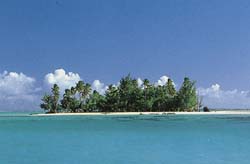 Polynesian Motu |
tiny isolated island, present population only 15. His home was just a shack on the beach, with a solar panel to power one tiny light bulb and his boom box. Fires blazed high on the beach as we got to know the nine yachties from nearly as many countries. The Italian owner (with Brazilian wife) of the HR 45 said they had found paradise and planned to stay two more weeks. They enjoyed long afternoon games of chess with Gretta and a pleasant friendship.
Day 15, yesterday, we studied diesel engines and electrical power systems in the morning, followed by long hikes along the coral, coconut tree motu. We met a pearl farmer, down the lagoon white sand beach whose wife was visiting Tahiti with 600 pearls to sell from their farm. He said they have a house in Maupiti, but prefer the tranquility and nature of Mopelia. The outer ocean coral beach was windy and wild with 20 knot winds and occasional rain squalls passing through and our crew came back aboard feeling like they had visited the movie sets for Gilligan’s Island and Castaway.
Day 16, this morning, I taught Storm Avoidance and Survival and Amanda showed our crew how to run our Pfaff 130 sewing machine. Mid-morning we got an email from our friend Leon Schulz in Sweden, in answer to my query of how the weather looked on internet sites for a Thursday arrival in Raro. Leon replied that a Wednesday arrival may provide more settled sailing conditions, recommending we set sail today. We took a vote, and everyone said, “Let’s go sailing!”. Before setting sail we motored out the pass and tried to anchor near the wreck of the WWI sailing-raiding ship, Seadler, which we snorkeled on during Leg 3-1997. The swells were too large, and we had to anchor further down the outer reef though still had an interesting snorkel before leaving.
Our winds have been 20-27 knots and seas a bit confused, so we just tucked a second reef into the main to slow the boat down. We have 375 miles to Rarotonga, so we need not hurry. We’re hoping it’s daylight when we pass Atiu, plus calm enough to anchor in the lee and go swimming as we did when passing the island in 1997.
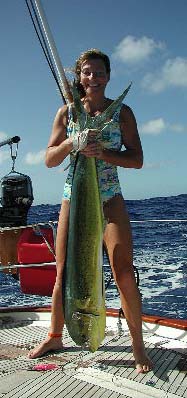 Another record Mahi from Amanda’s “Pinki” |
Leg 3, 2002, Update 3
September 8, 2002 1700 21.12S, 159.47W
Log: 61,567 Baro: 1015 Cabin Temp: 79F, Cockpit Temp: 75F
Tied to Cook Island Patrol Boat, Avatiu Harbour, Rarotonga
Day 17 provided 20-26 knot winds and larger SE swells than expected so we double-reefed the main and jib and had great sailing averaging 7.5 knots. Mid-morning we hooked the largest mahi mahi we’ve seen to date, and this fish was a fighter! For a while it felt like we had hooked a shark as she dived deep and kept crossing back and forth, refusing to surface. It took three of us to reel this lady in and when Amanda held it up, it was nearly as tall as her.
Day 18 held a mid-passage diversion, in the form of Mitiaro and Atiu islands. The direct course from Mopelia to Rarotonga goes between these islands, and we’d hoped to anchor long enough to swim. We sailed close along the coast of Mitiaro, waved at four people fishing off the beach, but large swells, no harbor and over 100′ depths close to the breakers kept us from anchoring. Atiu, another small island, population 300, is 24 miles away, and again, large surf kept us from getting close enough to anchor. However, Sam volunteered to standby with the boat, motoring off the reef while the rest of us snorkeled and swam edge of the surf breaking on the reef, marveling at the 100’+ visibility and huge fissures in the coral extending from shore.
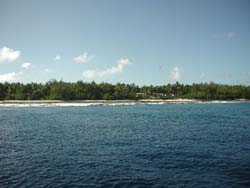 Atiu’s beach landing |
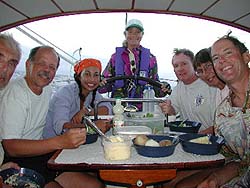 Last night dinner at sea – seared Cajun mahi |
After a quick shower back onboard we hoisted sail for Rarotonga and enjoyed a special sunset last-night-at-sea dinner in the cockpit, all thankful for new friendships and a safe and fun expedition.
Early morning on Day 19 the winds became light and as we’d been keeping track of a very active cold front a few miles south of Rarotonga, we decided motor and make some miles. However, the winds came back on an off for a few hours throughout the last 50 miles so we enjoyed peaceful sails whenever possible. After dawn we practiced sextant sun sights before tidying the boat for arrival.
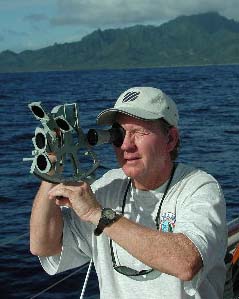 Ron practicing celestial navigation before landfall at Rarotonga |
It’s always exciting to see what boats are in a harbor, and if we can spot any old friends. As we entered Raro’s tiny, packed Avatiu Harbour, we didn’t spot any friends, and couldn’t see a single place to drop anchor where we wouldn’t be blocking another boat. We first tried anchoring bow and stern off the small boat ramp, but got told off by a dive boat. Then a friendly yachtie came over and suggested a spot, further in the harbor where we would be able to take stern lines ashore, instead of having to trust a stern anchor in this harbor famous for unreliable holding. By the time we were re-anchored, it was nearly 1700. In between I found time to run ashore and clear customs. Our good old harbormaster friend, Don Silk had just retired two days earlier, but the new harbormaster, John, formerly the captain of the Cook Islands patrol boat, Te Kukupa, has the same great attitude, and welcomed us back to the Cook Islands.
We had earlier warned our crew about Captain Jack’s, one of the South Pacific’s most notorious (and riotous) restaurant and bar. Perched on the edge of a harbor it overlooks the wrecks of the Yankee and an earlier steamship, it’s often washed through with hurricane waves and the walls are littered with the memorabilia of countless other shipwrecks. So it was only fitting that after HOT long showers ashore us tropical seasoned pirates gathered here for sunset drinks and a fabulous graduation dinner.
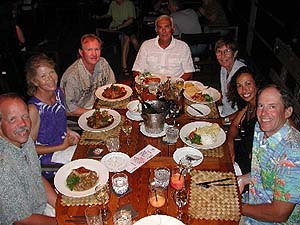
Graduation dinner ashore at Trader Jacks, Raro
Day 20 was the last day of instruction. We discussed and demonstrated changing communications for long distance cruisers with our Inmarsat Mini-M, C, SSB radio and Iridium satellite phone. We also practiced programming the Furuno weatherfax and discussed SailMail and WinMail. Next we borrowed and strung together 250′ of hoses to reach from shore to MT, gave our girl a proper wash down, filled our tanks, plus the tanks of four other yachts around us.
On shore we met an old friend from Penrhyn Island, in the Northern Cooks, Anis Kaitangi. After catching up on how our various Penrhyn friends are doing, I asked Anis, “Did you bring any pearls down from Penrhyn with you?” He lit up like a Christmas tree, as this was the subject he’d been dying to talk about! His immediate answer was, “You buy pearls?” I explained that I still had pearls from our last visit, but that our crew was interested in pearls. In a flash he was off on his motorscooter, returning shortly.
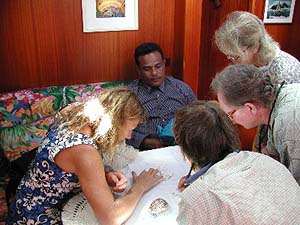
Crew fascinated with gold and black pearls from Penrhyn Island
You should have seen the looks on our crew’s faces as hundreds of gold and black pearls were rolled out on a white t-shirt. Quickly they decided which daughters, wives, girlfriends, etc. needed gifts of exotic South Seas pearls. After nearly cleaning Anis out from his stock of pearls, everyone took off in different directions, exploring. We met for a fun Indian dinner at Blue Note Café in town, with Zahra making a dramatic entrance, dressed to the nines and looking every bit like an Egyptian princess.
Yesterday morning the one spot in the harbor for a yacht to tie alongside, vs. anchoring with a bow anchor and stern lines ashore became available. Ron, Sam, Dorothy and Mark helped us retrieve both bow anchors and two stern lines and move Mahina Tiare into a tiny corner of the harbor where we are rafted to a lighter which is rafted to the patrol boat which is side-tied to shore. There is always a small jerky surge in the harbor and all seven lines to the ships and one line to a mooring are constantly working, but we no longer have to worry about anchors dragging or being run into or drug down upon by other boats. A bonus is that we can climb over the two ships and jump ashore, not having to rely on our dinghy.
 Tiny Avatiu Harbour, Rarotonga |
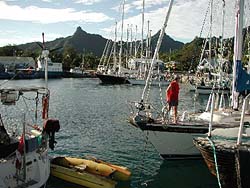 John securing M.T’s mooring lines – Avatiu Harbour |
This is a very special time for Amanda and I, when we really get to relax and enjoy one of our favorite islands. For the meager sum of US $3 per day we’ve rented mountain bikes that we use constantly. This morning we bicycled the 32 kilometers around the island, stopping for a long wander on the beach at Muri lagoon, and for a fish salad lunch at a little café. Tonight it’s a yachties potluck ashore and tomorrow we get to join a Hash House Harriers fun run up the mountain. (Amanda has signed up for a half-marathon next Sunday after completing a 10k fun run last Thursday). Tuesday night we’re invited to a barbecue at a friends house ashore and Wednesday we’re guest speakers at the Rotary dinner. Somewhere in there we want to find time to hike across the rugged interior of the island, snorkel in Muri lagoon and browse the trendy art galleries. And I guess we will need to find time for some boat maintenance and vegemite, opps I mean grocery provisioning.
What fun being in Paradise!
